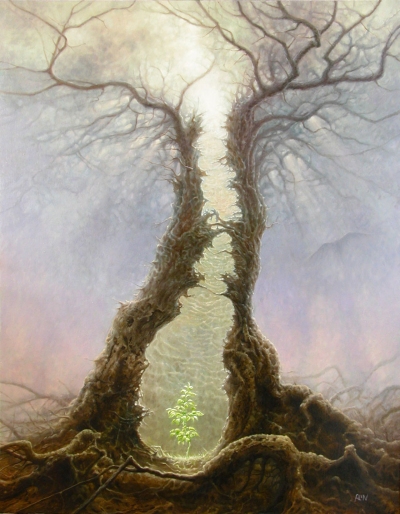“All mortal things, by necessity of Nature, revolve in a wheel of changes. … When they are born they grow, and when they are grown they reach their height, and after that they grow old, and at last perish. At one time Nature causes them to come to their goal in her region of darkness, and then again out of the darkness they come back into mortal form, by alternation of birth and repayment of death, in the cycle wherein Nature returns upon herself.”
— Hippodamus the Pythagorean
According to Robert Ellwood and Harry Partin, Neo-Paganism is “a new cosmic religion oriented to the tides not of history but of nature—the four directions, the seasons, the path of the Sun—and of the timeless configurations of the psyche.” Mircea Eliade defined a “cosmic religion” as one in which religious activity is centered around the mystery of the periodic renewal of life in the cycle of birth, death, and rebirth, manifested in the rhythms of nature and symbolized in the myths of deities who die and return to life.
In contrast to the monotheistic religions with their linear view of sacred time and the progressive view of history leading to a final eschatological event, Neo-Pagans view sacred time as cyclical, rotating between life and death in an eternal cycle of periodic renewal. This is what Mircea Eliade called the “Eternal Return.”
The Eternal Return is one religious response to what Eliade called “the terror of history,” the anxiety produced by our consciousness of our mortality and finitude, an anxiety that produces either denial or nihilism in the modern mind. The Abrahamic religions respond to this anxiety by sacralizing linear history, which is envisioned as a series of episodes in the continuous revelation of God progressing toward a culmination in a messianic age or last judgment. In the Dharmic religions of Hinduism, Buddhism, and Jainism, time is cyclical, not linear, but this cycle is perceived, not as something sacred, but as something to be escaped. The Eternal Return is a third response to the terror of history.
Neo-Pagans visualize time not as a straight line, but as a circle or a spiral (a combination of cyclical and linear time). The cyclical nature of existence reflected in the movement of the Sun, the Moon, and the stars, the changing of the seasons, the life cycle of plants and animals, and in our own biological and spiritual lives. In contrast to the Dharmic religions, which seek escape from this cycle, Neo-Pagans embrace it. Far from being a source of pessimism or despair, for Neo-Pagans, the ineluctability of death gives deeper meaning to existence.
Neo-Pagans believe in a dialectic continuity or complementarity of life and death. One of the most important insights of the Neo-Pagan metaphysic is that life depends on death, and that death can only be conquered by accepting it and being reborn. Joseph Campbell calls this palingenesis, the “eternal recurrence of birth.” All truly creative acts, said Campbell, derive from some sort of dying. This truth is manifested on both the cosmic and personal levels. On the cosmic level, we see it in the passage of the Sun and the changing of the seasons. On the personal level, it is reflected in both the biological life-cycle as well as the psychological “deaths” that we must endure in order to be reborn to a fuller life.
This principle is also expressed mythologically in the form of the Neo-Pagan Goddess. Unlike the omni-beneficent God of monotheistic religions, the Neo-Pagan Goddess is both creative and destructive, the one aspect necessitating the other. This is expressed in the aphorism, “The tomb is the womb, and the womb is the tomb,” which refers to the Goddess as both the ground or source of life and its ultimate destination.
Updated 2019
